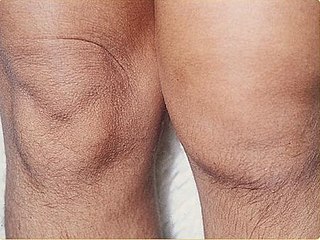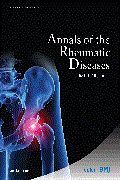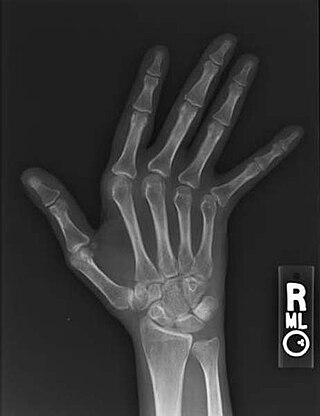
Giant cell arteritis (GCA), also called temporal arteritis, is an inflammatory autoimmune disease of large blood vessels. Symptoms may include headache, pain over the temples, flu-like symptoms, double vision, and difficulty opening the mouth. Complication can include blockage of the artery to the eye with resulting blindness, as well as aortic dissection, and aortic aneurysm. GCA is frequently associated with polymyalgia rheumatica.
Rheumatology is a branch of medicine devoted to the diagnosis and management of disorders whose common feature is inflammation in the bones, muscles, joints, and internal organs. Rheumatology covers more than 100 different complex diseases, collectively known as rheumatic diseases, which includes many forms of arthritis as well as lupus and Sjögren's syndrome. Doctors who have undergone formal training in rheumatology are called rheumatologists.
The National Institute of Arthritis and Musculoskeletal and Skin Diseases (NIAMS) is one of the institutes and centers that make up the National Institutes of Health, an agency of the United States Department of Health and Human Services (HHS).

Reactive arthritis, also known as Reiter's syndrome, is a form of inflammatory arthritis that develops in response to an infection in another part of the body (cross-reactivity). Coming into contact with bacteria and developing an infection can trigger the disease. By the time the patient presents with symptoms, often the "trigger" infection has been cured or is in remission in chronic cases, thus making determination of the initial cause difficult.
Mixed connective tissue disease, commonly abbreviated as MCTD, is an autoimmune disease characterized by the presence of elevated blood levels of a specific autoantibody, now called anti-U1 ribonucleoprotein (RNP) together with a mix of symptoms of systemic lupus erythematosus (SLE), scleroderma, and polymyositis. The idea behind the "mixed" disease is that this specific autoantibody is also present in other autoimmune diseases such as systemic lupus erythematosus, polymyositis, scleroderma, etc. MCTD was characterized as an individual disease in 1972 by Sharp et al., and the term was introduced by Leroy in 1980.
A nurse-led clinic is any outpatient clinic that is run or managed by registered nurses, usually nurse practitioners or Clinical Nurse Specialists in the UK. Nurse-led clinics have assumed distinct roles over the years, and examples exist within hospital outpatient departments, public health clinics and independent practice environments.
Palindromic rheumatism (PR) is a syndrome characterised by recurrent, self-resolving inflammatory attacks in and around the joints, consists of arthritis or periarticular soft tissue inflammation. The course is often acute onset, with sudden and rapidly developing attacks or flares. There is pain, redness, swelling, and disability of one or multiple joints. The interval between recurrent palindromic attacks and the length of an attack is extremely variable from few hours to days. Attacks may become more frequent with time but there is no joint damage after attacks. It is thought to be an autoimmune disease, possibly an abortive form of rheumatoid arthritis.

Barbara Mary Ansell, CBE, FRCP, FRCS was the founder of paediatric rheumatology. Ansell was notable for outstanding contributions to the advancement of paediatric knowledge, specifically defining chronic joint disorders and the improvement of their management.
John Cosh (1915–2005) was a British rheumatologist. He is known for his long term studies of the effects of rheumatoid arthritis, co-discovery of the genes associated with rheumatoid arthritis, and his work on the benefits of herbal medicines.
The American College of Rheumatology is an organization of and for physicians, health professionals, and scientists that advances rheumatology through programs of education, research, advocacy and practice support relating to the care of people with arthritis and rheumatic and musculoskeletal diseases.
Geriatric rheumatology is the branch of medicine that studies rheumatologic disorders in elderly. Sometimes it is called Gerontorheumatology.
Michael D. Lockshin is an American professor and medical researcher. He is a researcher of autoimmune diseases, with focus on antiphospholipid syndrome and lupus. He is currently professor of medicine and obstetrics-gynecology at the Weill-Cornell University Medical College in New York City. In addition, he is director of the Barbara Volcker Center for Women and Rheumatic Disease and co-director of the Mary Kirkland Center for Lupus Research, both at the Hospital for Special Surgery

Michael Gelfand, CBE, was a Zimbabwean colonial medical practitioner, who received a Papal Order of the Knighthood of St. Sylvester. Born in South Africa, Gelfand was noted for a humanistic approach to medicine and for his historical and ethnographic works. These played an important role in his re-examination of significant colonial prejudices he held about African peoples, culture, and religious practices.

The Annals of the Rheumatic Diseases is a peer-reviewed medical journal. It is published by the BMJ Group on behalf of the European League Against Rheumatism and covers all aspects of rheumatology, including musculoskeletal conditions, arthritis, and connective tissue diseases. The journal publishes basic, clinical, and translational research, as well as abstracts from conferences. The journal was established in 1939. Each issue, the editor-in-chief selects a paper to be published open access as an "Editors Choice". The editor-in-chief is Josef Smolen.

Rheumatic Disease Clinics of North America is a medical journal addressing topics in rheumatology.

The German Center for Pediatric and Adolescent Rheumatology in Garmisch-Partenkirchen is the largest specialized center for the treatment of children and adolescents with rheumatic diseases and chronic pain syndromes in Europe.
Patient satisfaction is a measure of the extent to which a patient is content with the health care which they received from their health care provider.

Jaccoud arthropathy (JA), is a chronic non-erosive reversible joint disorder that may occur after repeated bouts of arthritis. It is caused by inflammation of the joint capsule and subsequent fibrotic retraction, causing ulnar deviation of the fingers, through metacarpophalangeal joint (MCP) subluxation, primarily of the ring and little-finger. Joints in the feet, knees and shoulders may also get affected. It is commonly associated with systemic lupus erythematosus (SLE), and occurs in roughly 5% of all cases.

Axial spondyloarthritis is a chronic, autoinflammatory disease predominantly affecting the axial skeleton. The phrase itself is an umbrella term characterizing a diverse disease family united by shared clinical and genetic features, such as the involvement of the axial skeleton. The best-known member of the axial spondyloarthritis disease family is ankylosing spondylitis. The 2009 introduction of the expression axial spondyloarthritis made it possible to refer to (1) less severe forms of spondylitis, (2) the early phase of ankylosing spondylitis and (3) ankylosing spondylitis itself collectively.
Daniel Jeffrey Wallace is an American rheumatologist, clinical professor, author, and fellow. Wallace has published 500 peer reviewed publications, 9 textbooks, and 28 book chapters on topics such as lupus, Sjögren syndrome, osteoarthritis, and fibromyalgia. He has the largest cohort of lupus patients in the United States (2000). A full professor of medicine, he is associate director of the Rheumatology Fellowship Program at Cedars-Sinai. His seminal contributions to research include being an author of the first paper to demonstrate vitamin D dysfunction and the importance of interleukin 6 in lupus, conducting the first large studies of apheresis in rheumatoid arthritis and lupus, and insights into the mechanisms of action of antimalarials. Wallace's research accomplishments also include conducting many clinical rheumatic disease trials, examining the role of microvascular angina and accelerated atherogenesis in lupus, and work on anti-telomere antibodies which have garnered him 6 papers in The New England Journal of Medicine. Wallace's monograph, The Lupus Book, has sold over 100,000 copies since 1995.








